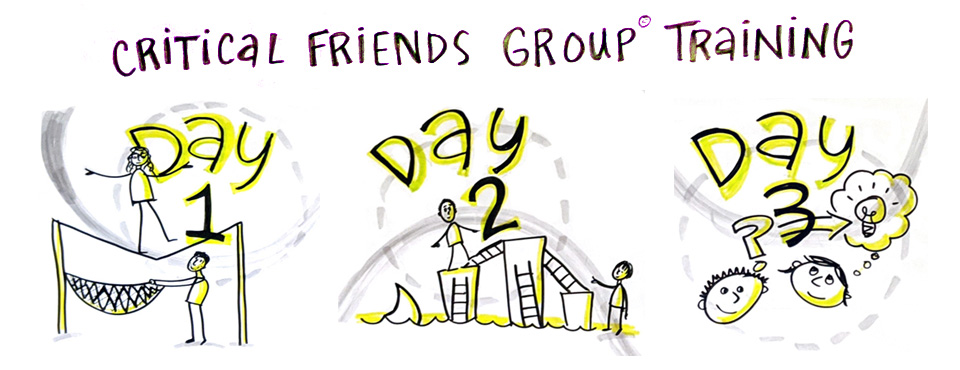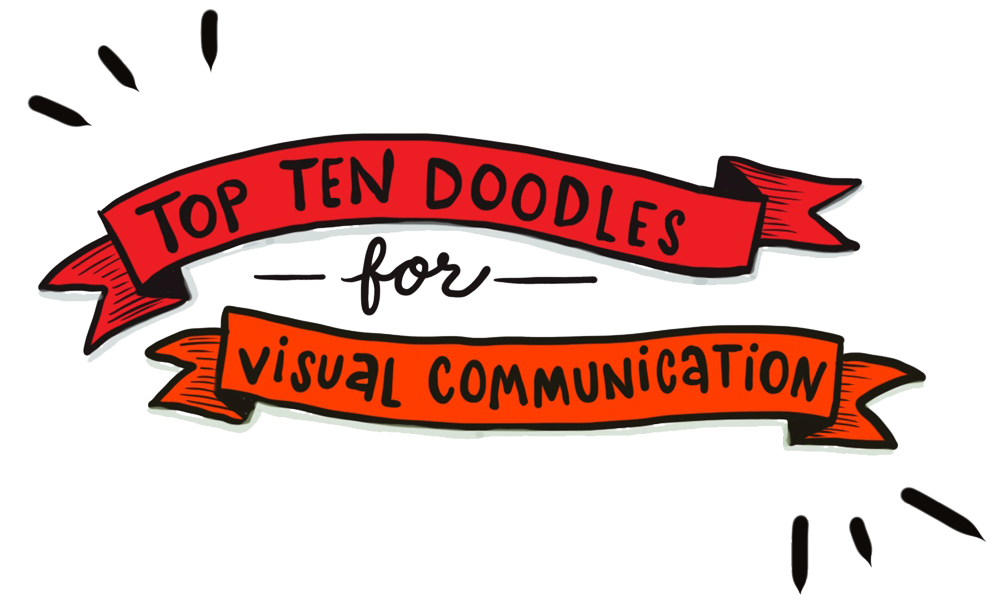I just had the best experience participating in – and simultaneously scribing* and sketchnoting** – a training on learning fun, powerful and practical ways for teams to work more effectively together.
Specifically for educators, these protocols are a process developed by National School Reform Faculty (NSRF) to train coaches in their Critical Friends Group® methodology with the intention of improving educator practices by making a positive shift in school culture.
I’m not an educator (although I was in my 20s) but I had an inkling this training would be appropriate for any group of people in any setting who need to work, communicate, solve problems and make decisions together.
How did I get here? Let’s back up a few months. I met the trainer Luci McKean last year at the always-stellar Combine conference in nearby Bloomington, Indiana where we were seated together at a table. I was meta-sketchnoting Mike Rohde as he presented about humanizing business with sketchnotes. That day Luci and I grabbed lunch together where I learned she is the former TEDxBloomington curator/organizer, a speaker coach, and professional facilitator.
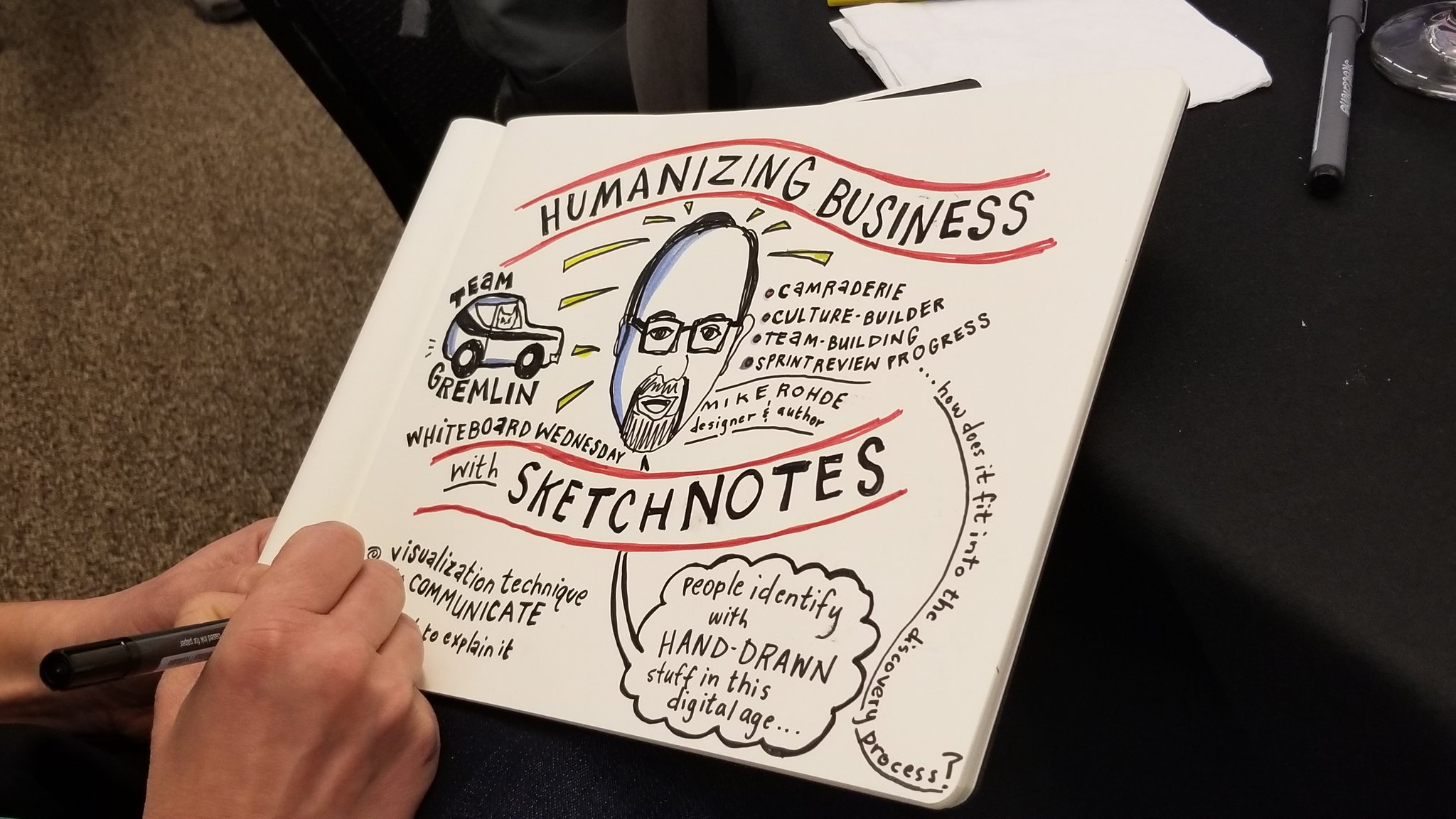
We stayed in touch and recently over another lunch I learned about this training she facilitates several times a year in her role at NSRF. It sounded so interesting. I was intrigued to learn a new set of team-building skills to add to my graphic facilitators toolbox so I suggested we work together, and Luci agreed. Her organization has worked with a visual practitioner before (although not during this specific training) so I was grateful she was open to the idea.
Luci the facilitator and I talked in advance to determine what would work best for both of us to meet our objectives during the training. Over the course of the training week I participated in some protocols, and captured others with visual notetaking.
Working together with about a dozen educators from around the country, we quickly went from being strangers to friends as we practiced the sequence of activities that make meetings more productive, efficient and effective.
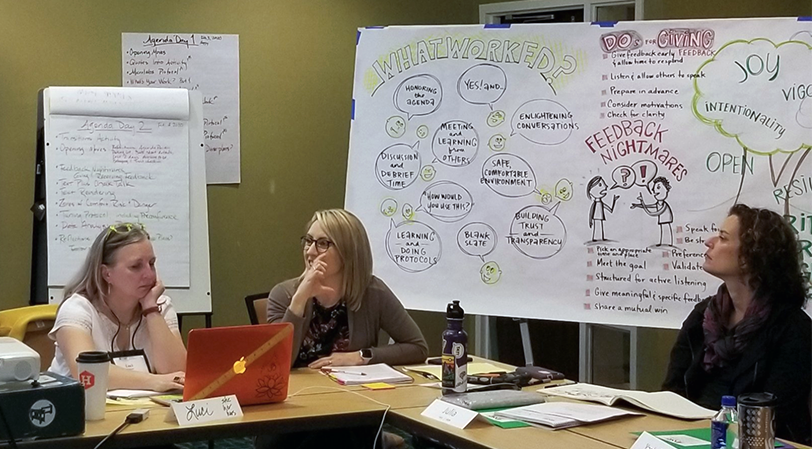
Photo by Rachel Hartley-Smith
Here are 5 things I learned about team-building:
- Relevant icebreakers build trust quickly
- I’m a big-picture kinda girl
- Silence is a precious place
- Don’t use data as a weapon
- Giving feedback without judgement or offering a suggestion is hard (but so worth it)
Relevant icebreakers build trust quickly
Have you ever been to a workshop that opens with an awkward, even uncomfortable icebreaker activity? Or one that has nothing to do with the group context (which is really counterproductive since effective icebreakers are supposed to “start people on the process of getting to know each another, but also introduce the topic of the event in a fun and interesting way”¹)? I know I have.
This experience was nothing like that. We began by circulating little cards, each with a powerful quote about education. We all chose one that resonated with us. Then working with a partner, we quietly took turns introducing ourselves, reading the quote and explaining why it was personally meaningful. We did this a few times with different people, and then on the last round were asked to introduce our final partner and their quote to the group, based on our conversation introductions.
After a few more trust-building activities I then live-captured the future coaches’ hopes and fears on a large poster, followed by a list of agreements we could all agree on. The activities, plus both discussions, all served to increase comfort in the room.
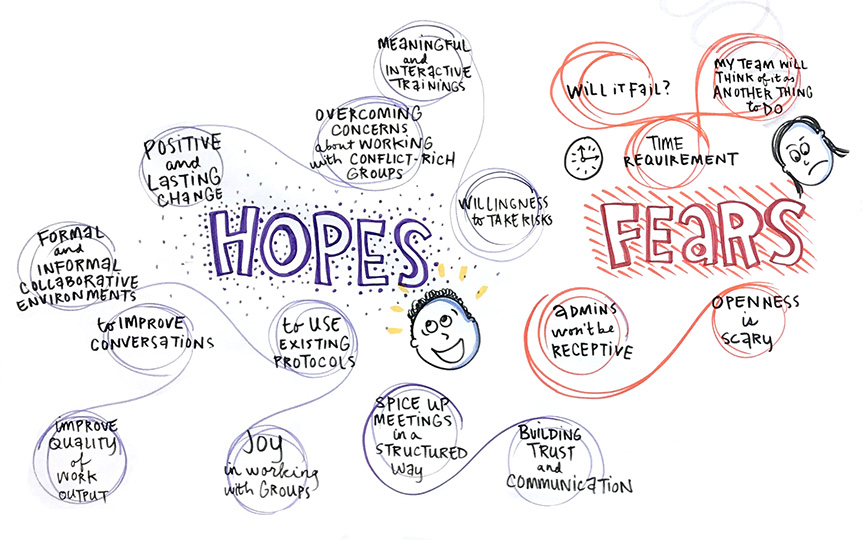
I’m a big-picture kinda girl
In the Compass Points protocol we aligned ourselves on one direction of a compass according to our gut feeling about how we individually work on teams:
- North = Action
- East = Big Picture (→ me!)
- South = Community/Communication
- West = Details
Working with the other self-identified “Easts” we discussed:
- Strengths and limitations of our style
- One or more other styles we have the hardest time working with
- What the other “directions” need to know about us to work with us effectively
- What we value about the other styles
After a report-back, debrief and silent reflection, my takeaways were that a) there are others like me!; b) I’m not always right; and c) it’s not personal when we experience a little friction with others’ behaviors during group-work.
These direction points were evoked throughout the entire training.
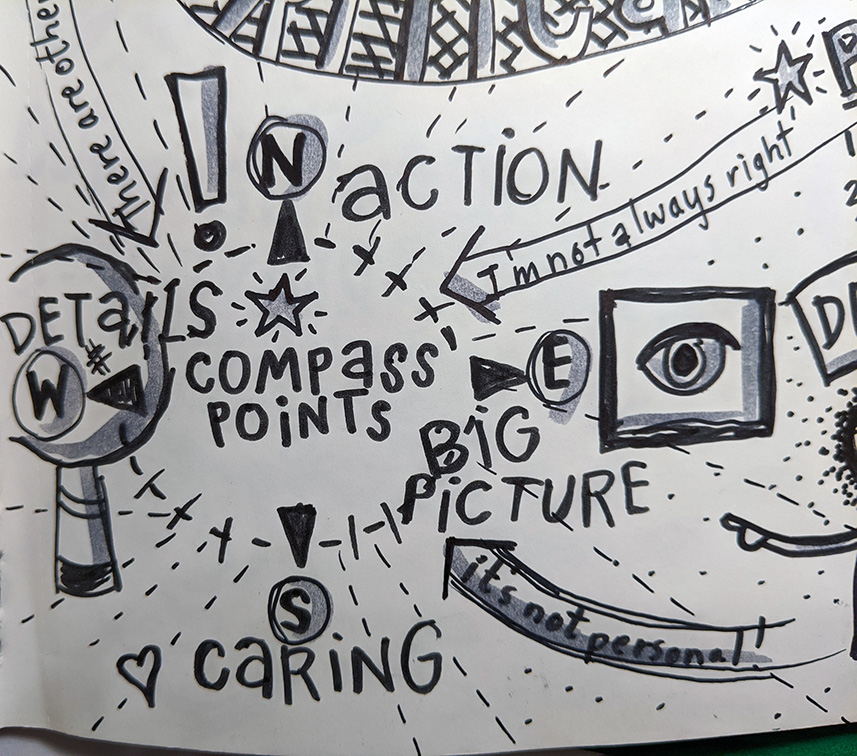
Silence is a precious place
Several of the protocols involved taking turns for individuals in small groups to talk, and even more importantly, to listen.
I appreciated this aspect of the work because I often find, in life, that it is difficult to express myself without being interrupted. And when I feel I am not being listened to, I either rush to speak quickly – to get it all out before I’m interrupted – or worse, don’t volunteer to express myself at all. It’s taken me a long time in my adult life to open up, to have the courage and strength to overcome this feeling of being shut up and consequently, shut down.
Silent reflection amongst participants post-protocol is also encouraged since “some people value quiet, reflective time to help them be here now.²” And it gives them time to think before speaking.
Additionally, as a facilitator, “the use of reflective silence is a powerful tool…a few minutes of silent reflection time can be an effective way to regroup, calm things down when the atmosphere gets tense, or to help participants articulate their responses effectively³.”
It can feel awkward at first to be in a group in silence, but it gets less weird as the practice becomes more familiar over time.
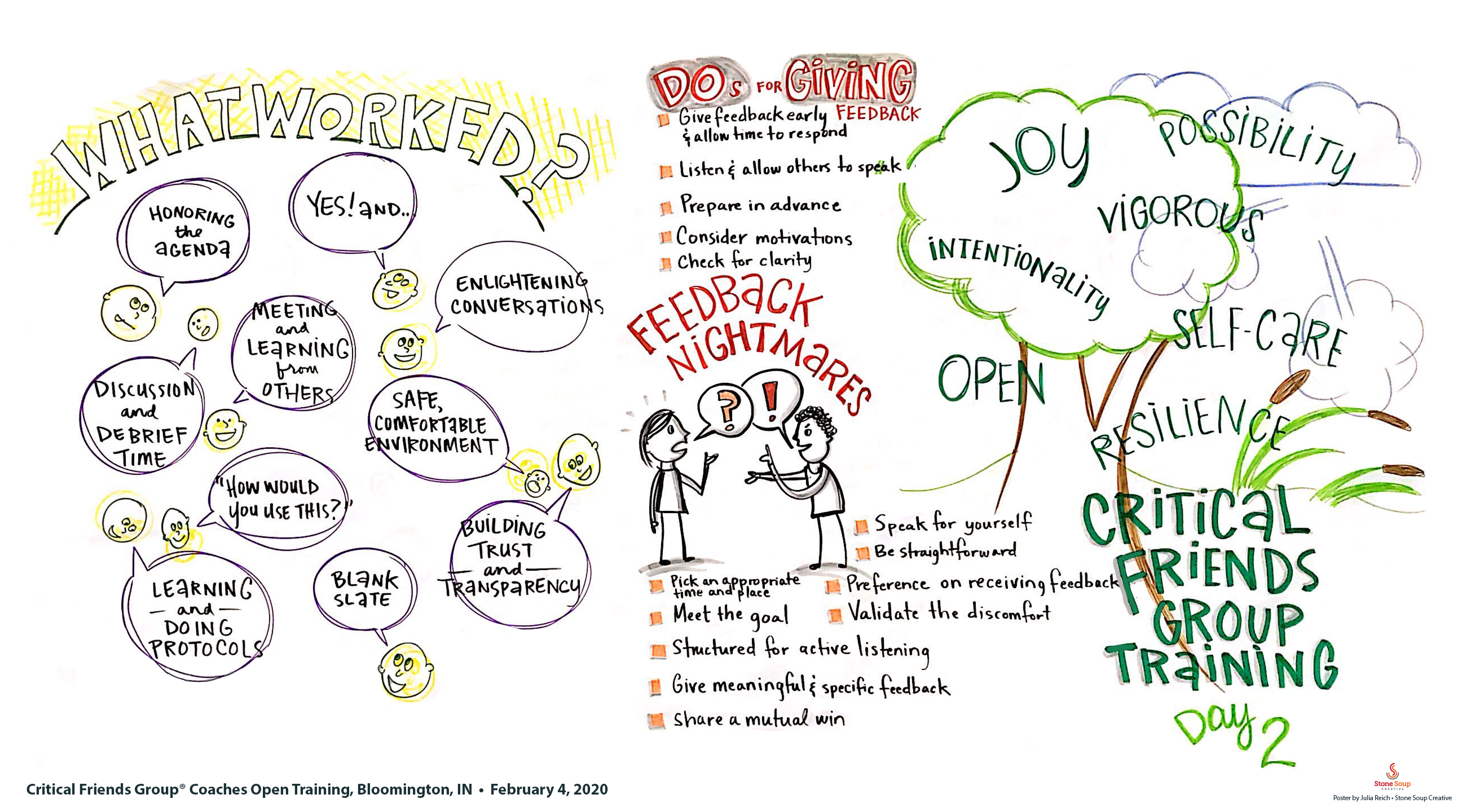
Don’t use data as a weapon
I am not a teacher, but I don’t need to be in the field of education to surmise that it is a highly politicized climate involving testing, evaluations, accountability, and school performance.
A couple of protocols in the CFG training effectively remove the pressure out of data discussions by using a structured dialogue approach to analyze real but anonymous data sets.
In our group, one of the participants brought an actual data set from her home district in Texas in the form of an Excel printout. It was scrubbed to exclude any identifying content and it was our job to systematically review the data set and first, taking turns by going around the room, make objective observations about what we literally see on the paper; next, surmise what the data set actually means; and finally, comment on what we think the implications are.
This exercise was a real revelation for me. As a creative professional I am often hired to design infographics around data – a type of project I really enjoy – but this analysis is provided to me. The client has already done the job of deciding what the important story is to tell in the numbers.
By listening to the others share their findings from the data sample – to know what patterns to look for, what appears significant or unusual, what to infer – opened up my eyes to what I missed and what skillful data interpretation looks like.
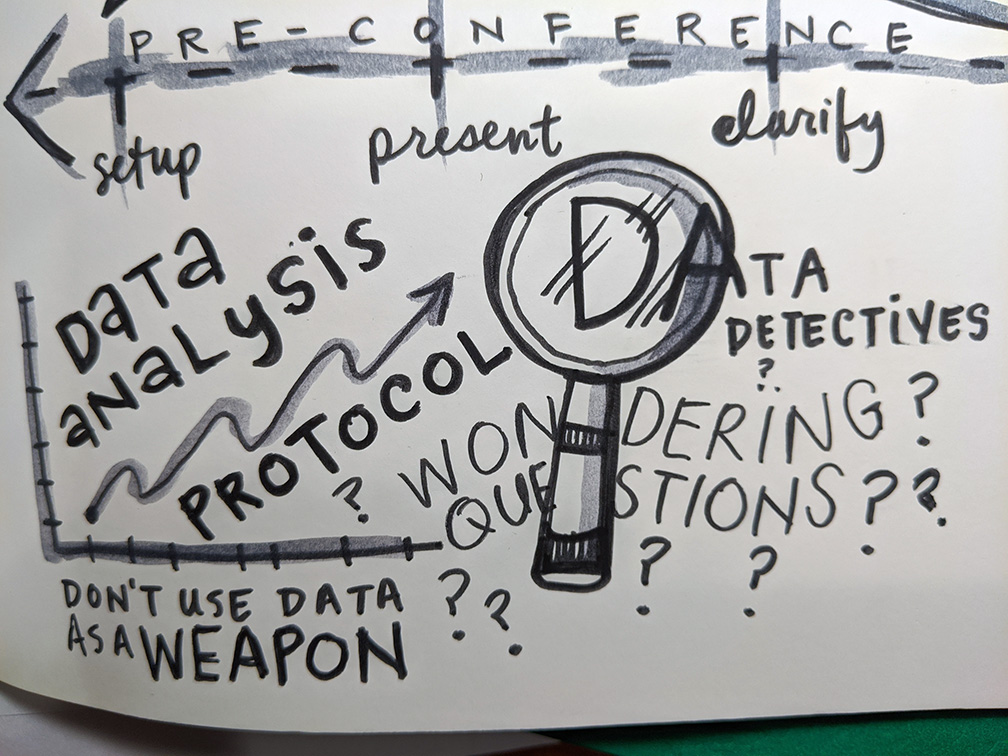
Giving feedback without judgment or offering a suggestion is hard (but so worth it)
Many of the protocols we practiced involved delivering feedback: to a peer’s comment, idea, or dilemma. Learning to give an appropriate response is powerful stuff. Delivered the wrong way, it can be a nightmare on the receiving end. Delivered in a constructive way, it can be encouraging and inspiring.
We learned to ask probing questions, intended to be open-ended and thought-provoking for the benefit of the person presenting an issue by empowering them to shift their thinking “from reaction to reflection”(4).
Possible probing questions (5) include:
- What is your ideal outcome?
- What evidence exists that ____________?
- In your heart, what do you feel is right?
Each of us practiced with a real-life dilemma we had considered in advance. Working in a small group and taking turns, as the one with the issue, I found the exercise yielded surprising insights: as a questioner, I was gratified to learn that being an “outsider” participant within a group of professional working educators yielded some powerful and objective probing questions.

The training is broken up into two parts during the school year: three days in Feb, and then two more days at the end of March, which I will also attend, and write up my experiences afterwards.
Part 2 of this post will focus on my experience of scribing the training, and how my graphic recording had an impact on how the facilitator and coaches experienced the training.
NSRF also offers this training at other points in the year, and often travel on-site to deliver personalized trainings to other groups: https://www.nsrfharmony.org
* Drawing live, on a large scale, in front of the entire group
** Drawing live visual notes in my notebook
¹ Michele Mattoon and Luci Englert McKean, Critical Friends Group® Coaches’ Handbook, NSRF, Harmony Education Center, 2015, pg. 91.
² IBID, pg. 92.
³ IBID, pg. 103
4 IBID, pg. 58.
5 IBID, pg. 61.
Want more on Visual Communication and Visual Thinking? Here's some related content for you.
Top Ten Doodles for Visual Communication
Drawing out concepts and ideas instead of writing down words is an effective way to communicate. Doodles are simple shapes and symbols that can be drawn in all kinds of situations. Plus it’s fun, and you don’t need to be an “artist” to do it.
